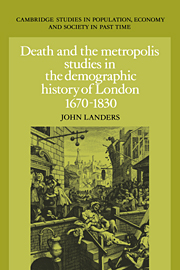Book contents
- Frontmatter
- Contents
- List of figures and maps
- List of tables
- Preface
- Acknowledgements
- Part I EIGHTEENTH-CENTURY LONDON AND ITS VITAL REGIME
- Part II THE LEVEL OF MORTALITY
- 4 Mortality among London Quakers
- 5 Mortality levels among the general population
- Part III DIMENSIONS OF LONDON'S EPIDEMIOLOGICAL REGIME
- Appendices
- Bibliography
- Index
- Cambridge Studies in Population Economy and Society in Past Time
4 - Mortality among London Quakers
Published online by Cambridge University Press: 05 November 2011
- Frontmatter
- Contents
- List of figures and maps
- List of tables
- Preface
- Acknowledgements
- Part I EIGHTEENTH-CENTURY LONDON AND ITS VITAL REGIME
- Part II THE LEVEL OF MORTALITY
- 4 Mortality among London Quakers
- 5 Mortality levels among the general population
- Part III DIMENSIONS OF LONDON'S EPIDEMIOLOGICAL REGIME
- Appendices
- Bibliography
- Index
- Cambridge Studies in Population Economy and Society in Past Time
Summary
The maintenance of vital registers was a central part of the Quaker religious practice or ‘discipline’, throughout the period with which we are concerned, associated as it was with their rejection of the established church and its parochial institutions (Lloyd 1950). Quakers were strictly endogamous throughout our period and their meetings conducted marriages, whose validity was recognised in law (Lloyd 1950: 51), buried their dead in Quaker burial grounds and maintained a sophisticated system of poor relief. The vital registers grew out of this system and differ from Anglican Parochial materials chiefly in their registration of births rather than baptisms (Rowntree 1902).
The quality of the vital registers maintained by the London meetings was generally high, the birth registers providing information on residence and occupation of parents, whilst before about 1800 the burial registers generally specify age and cause of death in addition to occupation and place of residence of the deceased or their parents. The information on age and cause of death was provided by the same ‘searchers’ who gathered material for the Bills of Mortality, and the cause of death categories in the Quaker registers are the same as those appearing in the latter.
The two meetings selected for analysis, those of Southwark and ‘Peel’, were both suburban. Southwark covered the built-up area south of the river including Rotherhithe and Bermondsey, as well as Southwark itself and the parishes of Lambeth, Camberwell and Newington Butts, initially rural areas which became urbanised in the latter decades of the eighteenth century.
- Type
- Chapter
- Information
- Death and the MetropolisStudies in the Demographic History of London, 1670–1830, pp. 131 - 161Publisher: Cambridge University PressPrint publication year: 1993

